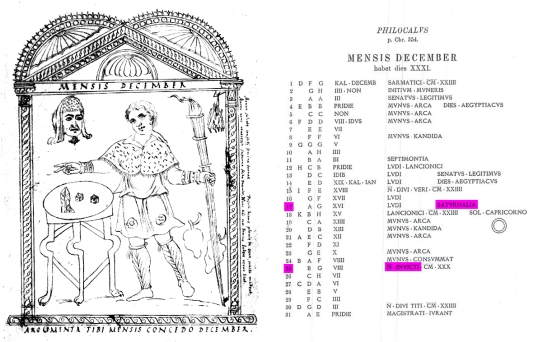Did you know that there was a long standing celebration that happened on December 25th before Christianity adopted it? The “Invincible Sun”, which was the official sun god of the Roman Empire was commemorated each year on the 25th of December just after the 7 day feast of Saturnalia done in honor of saturn. But where is the proof for such claims? Can we find solid evidence for such observances which are said to have happened on the 25th of December? Such a piece of evidence exists, and is known as the Chronography of 354.
The ”Chronography of 354”, also known as the ”Calendar of 354”, was a Roman Calendar with illustrations alongside various texts and lists, which was produced in 354 AD. It is the earliest dated western codex(Papyrus/Parchment sheets in form of a book) to have full page illustrations. The term ”Calendar of Filocalus” is sometimes used to describe the whole collection, and sometimes just the sixth part, which is the Calendar itself. Other versions of the names (“Philocalus”, “Codex-Calendar of 354”) are also occasionally used.
The Calendar itself contains important Roman Dates and festivities such as “Birthdays of Emperors”, “Birthdays of Popes”, “Games” & “Chariot Races”. Amongst these festivities are the celebration of “Saturnalia” and “Birthday of Invictus(Invincible Sun)”. Saturnalia being celebrated on 17th December (7 Days leading upto the 25th) and “Birthday of Invictus” celebrated on the 25th of December are marked on this Calendar which dates back to 354AD.
You can view the complete calendar here or by reading the book titled “On Roman Time: The Codex-Calendar of 354 and the Rhythms of Urban Life in Late Antiquity” by Michele Renee Salzman.(Some of the pages can be viewed on Amazon as well)
The below page (click image to see enlarged view) contains the main Illustration of December alongside the festivities of the said month. (I have highlighted “Saturnalia” and “Natatalis(Birthday) Invictus” on the image for easy reference)
Abbreviations on the above calendar page
CM = Circenses missus (‘games ordered’)
N = Natalis (‘birthday’)
LVDI = games
SENATUS LEGITIMUS = Senate allowed (days on which the senate could sit)
DIES AEGYPTIACUS = Egyptian days (unlucky days)
CM = Circenses missus (‘games ordered’)
N = Natalis (‘birthday’)
LVDI = games
SENATUS LEGITIMUS = Senate allowed (days on which the senate could sit)
DIES AEGYPTIACUS = Egyptian days (unlucky days)
Description of Main Illustration – According to Salzman (pp. 75-6), the picture illustrates the “Saturnalia”, since gambling with dice (The dice are placed on the table) was allowed only during this holiday. The mask represents the custom of dressing in costumes (especially cross-dressing) that is characteristic of both Saturnalia and Carnival (Lawson 221-231). The fringed or tasseled mantle is a characteristic of shamans (Butterworth, Traces, 167-8), as is the tasseled Medusa mask (Butterworth, Traces, pp. 151-2, 164-7, plates IX, XV-XVII). The figure in the Calendar also wears the calliculae (or galliculae), which reflect evil, and are also standard accoutrements of priests (Mollet, s.v.) and of shamans (Butterworth, Traces, pp. 30n, 162-8, plates X, XV-XVII).






No comments:
Post a Comment
Note: Only a member of this blog may post a comment.